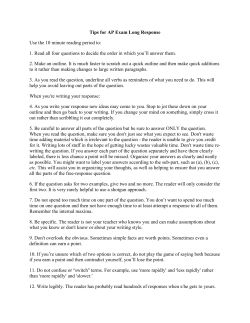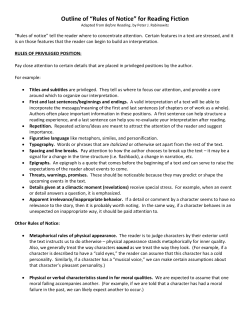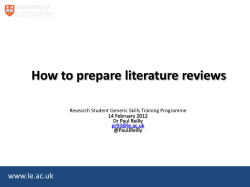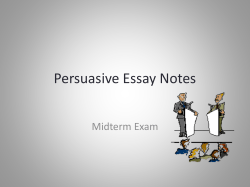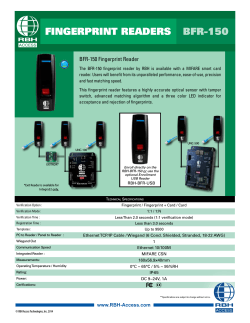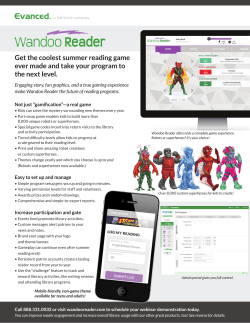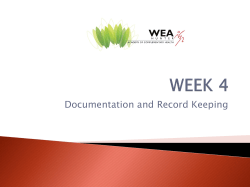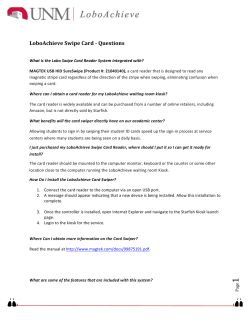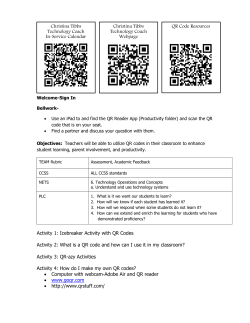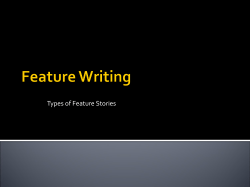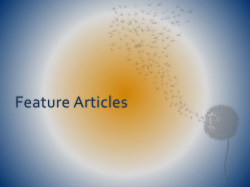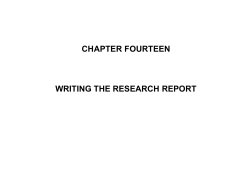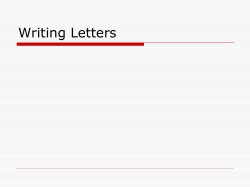
THE MODES OF WRITING: HOW TO WRITE FOR DIFFERENT
THE MODES OF WRITING: HOW TO WRITE FOR DIFFERENT PURPOSES Created for Edmond Public Schools© NARRATIVE WRITING The Purpose of Narrative Writing: To tell a story To recreate an experience (real or imagined) To give an account (fiction or nonfiction) Use the following strategies to write narrative text: Plan your story with conflict and resolution in mind. Think of the conflict as a problem, a mystery, a question, or a lesson to be learned. Include all important elements: characters setting events or plot conflict resolution Grab the reader’s attention with an exciting or unexpected lead! Set the stage; time and place are important. Setting creates a mood or tone. Make complex characters who “grow” or learn something. Tell how someone struggled, changed, or made something happen. Use dialogue and action to present characterization; in other words, let the character’s words and deeds show what he/she is like. Use foreshadowing to make the events believable. Solve a mystery or build up to a discovery. Make the reader wonder what will happen. Use chronological sequence: beginning, middle, end. Once you resolve the conflict, end your story before you become boring. DESCRIPTIVE WRITING Purpose: To tell about the characteristics of a person, place, or thing To tell about the features of a subject, event, or process To create a picture in the mind of the reader To give the reader a strong sense of “being there” or “seeing it” Use the following strategies to write descriptive text: Appeal to the reader’s senses (sights, sounds, feelings...). Close your eyes and try to “be there.” Look for and listen to the little things other people miss. Pay attention to the unusual. Practice observing people, actions, and situations carefully; take notes in a journal. Use figurative language to develop images. Choose words that double as images rather than using mere descriptive words. Use strong action verbs to bring the piece to life. Make the reader able to picture it through word choice. Vary your sentence structure. Details become the “icing on the cake” as you describe. Find vivid, exciting adjectives and adverbs. Compare and contrast things that seem similar or different. Let your own personality (your “voice”) shine through! EXPOSITORY WRITING Purpose: To inform To explain an issue, a situation, or point of view To share facts about a particular subject To guide the reader to a clear understanding of the subject Use the following strategies to write expository text: Know your topic! Research carefully to find all appropriate facts on your topic. Select only the best information from your research. Organize points by order of importance or degree. Make sure that each fact clearly relates to the topic. Be choosy! You can’t tell everything! Be picky! Supporting Details: Use statistics. Use examples. Use reasons. Liven it up by using a good story (anecdote) to make a point. Use figurative language; without it, your writing is like a clock without a battery! Use a variety of sentence structures or your reader will fall asleep. Use clear language by paying attention to your word choice. Tell about the causes of something. Tell about how to do something. Tell about the different kinds of something. Turn a little-known subject into a familiar subject. Read your paper from another person’s point of view. Have your anticipated the reader’s questions? Have you addressed them before they were even asked? PERSUASIVE WRITING Purpose: To change the reader’s mind or attitude To influence the reader’s thinking To prompt the reader to do something To convince the reader to accept the writer’s position or opinion To take a clear stand on something and stick with it Use the following strategies to write persuasive text: Dig up all of the facts first! Make sure that the evidence does not lack credibility. Sort through all available information to choose the strongest, most convincing points. Leave out weak, unconvincing, or misleading information. Consider all sides, but argue in favor of only one; don’t be wishy-washy. Make your opinion strong by backing it up with strong facts. Impress the reader with your knowledge of the facts. Make your position obvious through clear word choice. Revise, revise, revise! Use a variety of sentence structures to keep the reader’s interest. Use transitional language for a smooth, fluent flow of ideas. Use figurative language; the mighty metaphor is a powerful tool in persuasive writing. Ask others to read your paper to judge whether you have constructed your argument clearly enough. Never lose sight of your main point or thesis statement!
© Copyright 2025
